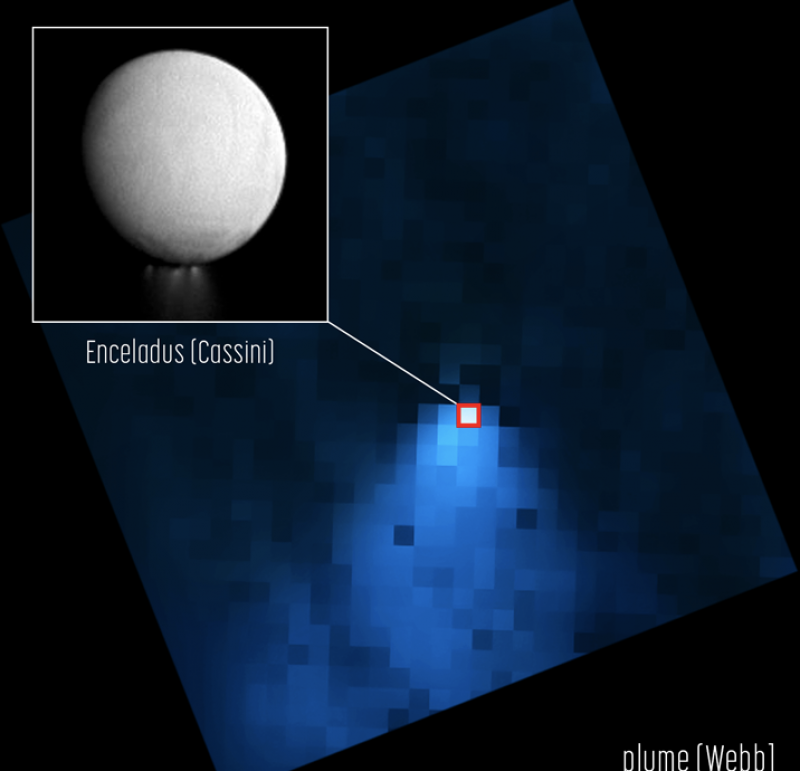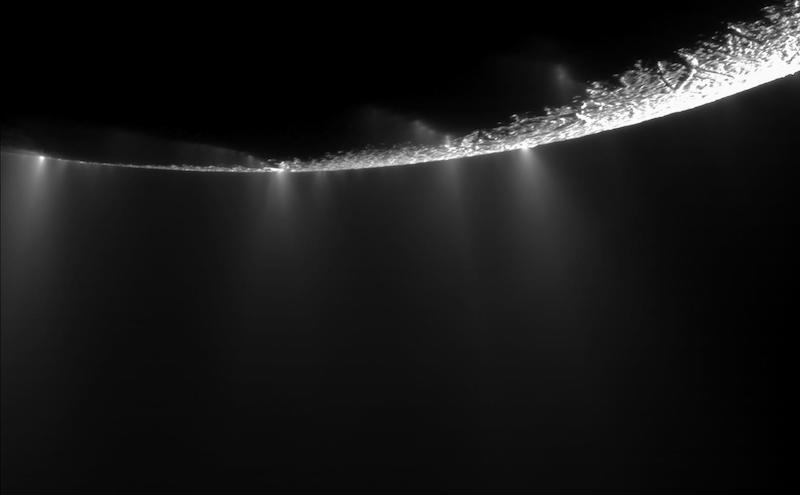
EarthSky originally published this story on May 25, 2023. But the Webb image (at top) had not been released yet. NASA finally released the Webb image on May 30, 2023. Isn’t it amazing?
Saturn’s moon Enceladus is famous for its huge, active plumes of water vapor. They erupt like geysers at this little moon’s south pole. NASA’s Cassini spacecraft discovered them in 2005. And scientists quickly surmised that the plumes originate from a global ocean below the surface of Saturn’s moon. That subsurface ocean might be inhabited by living things. So the plumes might contain evidence of life. In May 2023, we began to hear that the James Webb Space Telescope (JWST) has now taken a new close look at Enceladus. Webb has observed a new, much larger plume.
The water vapor plumes on Enceladus can be huge, generally speaking. They tower above the moon’s icy surface. Consider that Enceladus itself is only about 314 miles (505 km) wide. The plumes spotted by Cassini were known to be at least as tall as the moon’s diameter. But this new plume – observed by Webb – is the biggest one ever seen, many times the diameter of Enceladus itself. As Sara Faggi, a planetary astronomer at NASA’s Goddard Space Flight Center, said:
It’s immense.
Biggest water plume on Enceladus ever seen
We haven’t seen a statement from scientists about the new plume.
But Alexandra Witze wrote about the new plume in Nature on May 18, 2023.
And Faggi mentioned the plume and the Webb observations at a conference at the Space Telescope Science Institute in Baltimore, Maryland, on May 17.
While few details were presented at the conference, Faggi said that a new paper will be coming out soon.
Many times Enceladus’ diameter
The water vapor erupts through large cracks in Enceladus’ icy surface. Scientists call these cracks tiger stripes.
The venting was known for sending the water vapor and other particles it contains a long way from Enceladus, out into space. But this newest eruption sent spray from the moon’s interior even farther out, up to many times Enceladus’ diameter of 314 miles (505 km).
Webb was able to observe this plume on November 22, 2022, and scientists have been studying the data sent back ever since.
Cassini analyzed particles in the plume that were relatively close to Enceladus itself. But Webb has the advantage of being able to look at plume particles that travel much farther away from the little moon. The ability to study both will help scientists better understand the plumes and the rich variety of ingredients they contain.
New analysis of Enceladus’ plumes
The analysis of the plume material, to be presented in the forthcoming paper, should be quite interesting. Cassini previously found that the plumes contain water vapor, ice particles, salts, silica, carbon dioxide, ammonia, methane and organic molecules.
Webb observed the plume for only 4.5 minutes, but that was ample time to obtain the data needed. The analysis will provide more details about how much water vapor the plume contained and the temperature. This plume, however, since it is so spread out away from Enceladus, is likely much more diffuse than the plumes Cassini saw (and actually flew through!). That may make it more difficult to determine what kinds of organic molecules were in the plume. Cassini did find a variety of both simple and complex organic molecules during its mission, however. As Witze wrote:
But the plume is likely to be of low density, more like a diffuse, cold cloud than a damp spray. That’s not great news for anyone looking to grab samples from the plume and hoping to find life, because the signs of life might be too sparse to detect. Ice grains seen by Cassini much closer to Enceladus are more likely to have high concentrations of organic particles, says Shannon MacKenzie, a planetary scientist at the Johns Hopkins University Applied Physics Laboratory in Laurel, Maryland.
With that in mind, Webb did find an abundance of intriguing chemicals in the plume. Witze wrote:
JWST also analyzed the spectrum of sunlight reflecting off Enceladus and found evidence of many chemicals, including water and possibly other compounds that could hint at geological or biological activity in the moon’s ocean.
What are they? We’ll have to wait to find out, but as Faggi noted:
We have many more surprises.
Life on Enceladus?
The plumes are of special interest to science because they might contain clues about possible life in Enceladus’ subsurface ocean. The ingredients found so far are tantalizing, although not proof yet that the ocean harbors living organisms.
Cassini did also find evidence suggesting that there are hydrothermal vents on the ocean floor. If so, they could possibly be a source of heat and nutrients, just as they are in oceans on Earth.

Future missions
As of now, there are no confirmed missions going back to Enceladus. But there are ideas on the drawing boards, such as a combination of orbiter and lander called Orbilander. Read the concept study here. A return mission will be essential to find out whether life ever has existed on Enceladus, or still does.
Bottom line: NASA’s Webb Space Telescope has observed the largest water plume on Enceladus ever seen. Details about the analysis results will be published in a new paper.











